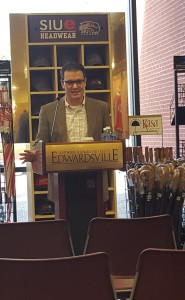Professor’s book explores the history of Minnesota’s mining towns
The stories of the iron mining communities in northeast Minnesota may often get overlooked in American lore.

SIUE history professor Jeff Manuel speaks at his book signing event at the University bookstore in April. (Photo courtesy of Jeff Manuel)
Like the California gold rush, thousands fled to the region during the 19th century to mine huge deposits of iron. But during the 20th century, the industry fell into a steady decline that continues to this day. The economic prosperity of these towns hinges on whether the mining continues. What happens to the people in those communities?
SIUE history professor Jeff Manuel delves into this question as he explores the subject in his new book “Taconite Dreams.” Dr. Manuel hosted a book signing at the Morris University Center on March 5. The iron ore mining region extended from northeastern Minnesota into northern Wisconsin and Ontario, Canada. Small towns and their economies were centered around the mining business and the town’s fate often was tied to the viability of the mines. Manuel details the history and decline of the mining communities in his book.
“The towns really grew up as mining towns,” Manuel said. “When the mines are threatened with decline, then there’s the question of what’s going to happen to the towns. Will they become ghost towns like you see in the western United States or will they continue on? They made the decision to do everything possible to keep the towns going and that’s what I look at in the book.”
Manuel’s book covers the time period beginning with World War I to the present. He details how European immigrants from Italy, Sweden and eastern European countries migrated to the region in search of work. Manuel said that Iron Ore mining reached its peak during World War II. Manuel argues that the region has been in a slow decline throughout the 20th century, which put a strain on the mining towns’ economies.
“They’ve really struggled,” Manuel said. “There’s a big global recession in the steel industry right now. There’s a half dozen major giant mines open in the region; a lot of those have been shut down temporarily because of the recession.”
Dr. Manuel’s research focuses on 20th century resource industries, deindustrialization and energy history during the 20th century. He teaches U.S. History courses and the history of technology at SIUE.
“I’ve always been interested in this question of deindustrialization; the shutdown of heavy industry and how communities respond to that,” Manuel said. “I’ve found that many of the stories that have been told were kind of Rust Belt cities, Detroit, Pittsburgh or places like that but the Iron Range was a really important part of the U.S. steel industry and the global steel industry and that story hadn’t really been told yet.”
Filed Under: Historical Studies












